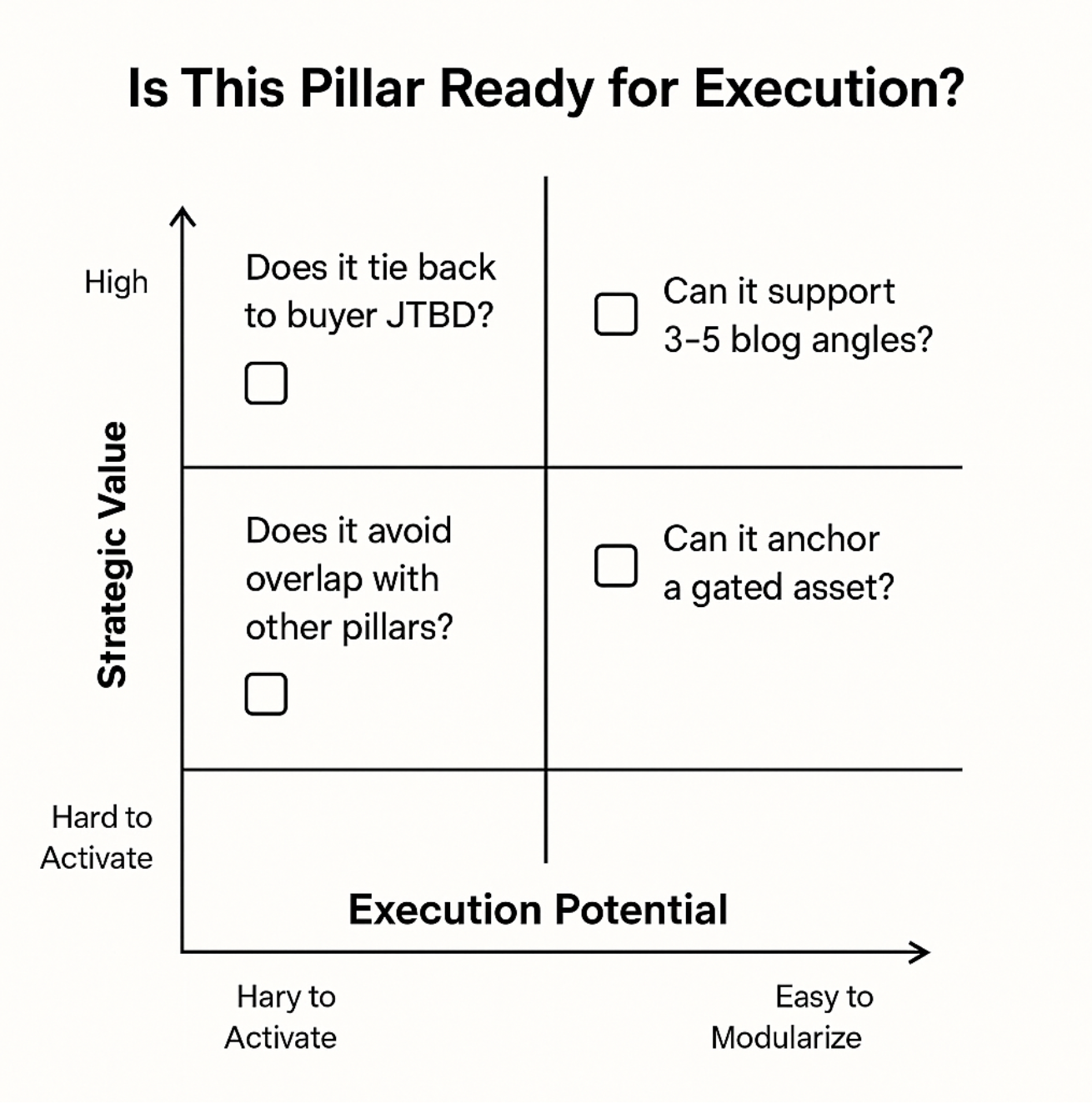Using AI to Build GTM-Aligned Content Pillars Faster
AI won’t build your strategy, but it can accelerate the path to clarity.
If execution is your engine, pillars are the blueprint, and building them from scratch takes time. This post explores how AI can help content leaders develop GTM-aligned content pillars faster, acting as a thought partner for research synthesis, buyer insight mapping, and early pillar testing.
AI helps you synthesize research inputs, from interviews to competitive intel.
JTBD-style prompts turn messy notes into actionable content themes.
Pillar concepts become testable when AI simulates real outputs.
You still make the calls. AI just accelerates the path to clarity.
What’s a Content Pillar?
In this blog series, a content pillar refers to a strategic message or theme that aligns with your GTM priorities and anchors multiple assets across the funnel. Each pillar supports a distinct buyer job-to-be-done and is designed for modular reuse across blogs, campaigns, sales decks, and gated content.
Building Strategy Is Slower Than Execution. AI Helps Close the Gap.
In a previous post, I broke down how to structure content pillars that actually support your GTM strategy, using tools like the Capability Fit Matrix and the Content Structure Ladder. That post focused on what makes a strong pillar and how to shape it into reusable campaign infrastructure.
This post zooms out to an earlier phase: how to accelerate the development of those pillars using AI as a strategic thought partner. Not to generate strategy from scratch—but to move faster through the early steps: synthesizing insights, mapping buyer needs, and pressure-testing your ideas before you commit.
AI helps content leaders translate messy GTM inputs into a clear, modular pillar system—faster.
Synthesizing Strategic Inputs With AI
Before you define content pillars, you need strategic signal. That usually means:
Interview notes and stakeholder conversations
Industry trend reports
Sales feedback and common objections
Insights from past content performance or audits
Individually, these are just data points. But together, they can reveal the patterns that should shape your strategy—if you can synthesize them fast enough. That’s where AI comes in.
Prompt AI to help:
Summarize transcripts with a focus on buyer goals, anxieties, and success language
Cluster inputs into themes (e.g., repeated objections, high-value capabilities)
Flag disconnects between internal positioning and what buyers actually care about
This turns messy research into usable insight, so you’re not building your pillars on hunches.
Turning Insights Into Early Pillar Hypotheses
Once you’ve made sense of your inputs, it’s time to turn that clarity into pillar candidates. AI can help you move from idea fragments to early hypotheses worth pressure-testing.
Prompt AI to:
Generate multiple phrasing and naming options for each pillar
Highlight overlaps or redundancies between candidate ideas
Suggest messaging variations for different buyer types or funnel stages
Draft early ladder structures from pillar → campaign → asset
This is where AI shifts from summarizer to co-ideator, not to make the strategic calls, but to multiply your options and sharpen your thinking at speed.
Mapping Buyer Jobs-to-Be-Done—Faster
JTBD frameworks are essential for strategic pillar development, but they’re time-intensive to build and validate. AI can’t talk to your buyers, but it can help you:
Generate hypotheses about buyer motivations, success triggers, and anxieties
Translate those into early messaging themes worth pressure-testing
Reframe internal capabilities in buyer-first language
Example
Feed AI 3–5 interview summaries and a product overview, then prompt:
“What job is this solving for the buyer?” or
“Segment these buyer needs by funnel stage: awareness, consideration, purchase.”
You’re still responsible for judgment, prioritization, and nuance.
But AI gives you a strong head start, so you can move from raw insight to strategic input faster.
Using AI to Pressure-Test Your Pillars
Once you’ve drafted potential pillars, don’t stop at the label. Use AI to test whether each pillar holds up when translated into real content.
Prompt AI to:
Write three blog titles that sit under this pillar
Turn a capability into a CTA for a white paper
List five LinkedIn angles tailored to a medtech buyer
Propose a research concept or thought leadership POV this pillar could anchor
This helps you:
Gauge how strong, or vague, each pillar really is
Identify which ones support modular reuse across formats
Spot overlap or redundancy early
Confirm whether a pillar can anchor repeatable, high-impact campaigns
Refining now saves you time (and headaches) later, before you commit to scaling a weak idea.
Before you commit to a pillar, test whether it can support the content system you need.
What Content Leaders Should Take From This
AI can’t define your content pillars but it can accelerate every step of developing them. From synthesizing buyer signals to simulating content angles, it helps you move from raw input to strategic clarity faster.
AI speeds up synthesis and iteration. It turns messy research into usable building blocks.
You still need a clear GTM lens. Inputs matter: buyer language, sales feedback, and capability snapshots shape the strategy.
The strategist makes the calls. AI multiplies your direction, but it can’t replace it.
Faster doesn't mean shallower. With the right prompts and system, AI supports stronger pillars, not just faster ones.
If you’re thinking like a strategist, AI isn’t a shortcut. It’s your accelerator.
About Me
I’m a content strategist who designs and runs full-funnel content systems for complex B2B orgs. This blog series shares the real frameworks and execution approaches I use to build GTM-aligned content, from positioning through performance.

